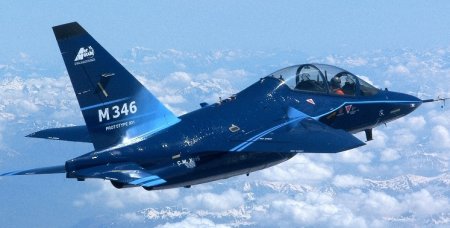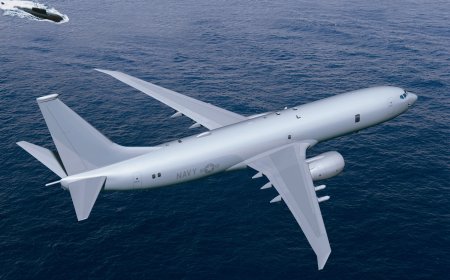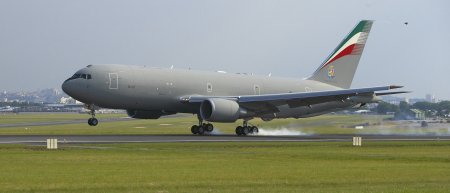Budget restrictions threaten the Italian air force’s rationalisation programme. Can the service find a way to beat the squeeze?
The Italian air force is facing parallel challenges: to complete the ongoing procurement and modernisation of its fighter, transport, in-flight refuelling and surveillance aircraft fleets, while also battling to overcome the impact of ever-decreasing funding from the national government. The service must also balance these requirements against an increased demand for airspace control following 9/11 and the need to support the out-of-theatre, coalition-style military missions that it is increasingly being asked to carry out.

Key procurement efforts for the air force include its introduction of the Eurofighter Typhoon air-superiority fighter, Boeing KC-767A tanker, Alenia C-27J tactical transport and the planned replacement of its AMX strike aircraft and part of its Panavia Tornado fleet with Lockheed’s F-35 Joint Strike Fighter. Two major surveillance requirements have also yet to be decided: the acquisition of a new maritime patrol aircraft – possibly Boeing’s 737-based P-8A Multi-mission Maritime Aircraft (MMA) – and the introduction of a national airborne early-warning and control (AEW&C) fleet.
Balanced force
The good news is that the air force at last has a clear programme intended to rationalise its combat fleet and deliver a reasonably efficient and balanced force. The bad news is that Rome’s annual defence expenditure is steadily declining, recently dipping below the psychological threshold of 1% of gross national product (GNP). This year, despite a slight increase in the overall defence budget to €19.5 billion ($23.6 billion), proposed government spending cuts will reduce military expenditure to just €12.1 billion, or 0.84% of GNP: the lowest level in Italy’s history. The sum also includes personnel costs, which alone account for almost 60% of the total budget.

At first analysis, it appears evident that Italy’s 2006 defence budget will not provide for a full allocation to support the Eurofighter programme, with the air force’s Predator unmanned air vehicle, maritime patrol and Sicral satellite programmes also facing shortfalls. The air force is not alone in facing such a crisis, with army armoured vehicle projects and navy frigate and submarine procurements also at risk.
The Italian air force is reacting to these challenges by slightly downsizing and rationalising its force. The service has 47,000 professional personnel and 5,400 civilian employees, but is expected to settle at a staff level of 44,000 by 2007. This marks a steady decline, with almost 50,000 professional staff having been employed in 2003.
The air force has also begun a process to reduce its number of operational units, including the withdrawal of the Lockheed F-104S Starfighter and the return to the UK of leased Tornado F3 interceptors. The service now has two fighter divisions operating 14 combat squadrons, with its total strength comprising 34 active squadrons at 26 air bases. It also has 10 surface-to-air missile squadrons located at four sites.
The service recorded almost 115,000 flight hours in 2004, including search-and-rescue tasks. The relatively new missions of interception and air policing to identify and escort “intruders” into Italian airspace – mostly civil aircraft with communication or navigation problems – accounted for 28 scrambles by pairs of Lockheed F-16A fighters last year. This level of activity increased to 30 missions in the first eight months of 2005. Such potential counter-terrorism missions are becoming increasingly important, and rely on the availability of interceptors, tankers, air-defence missiles and the co-operation of NATO-owned Boeing E-3 Airborne Warning and Control System aircraft during major events such as the G8 summit.
Missions abroad
Also demanding, and wearing for deployed assets, are military missions abroad, such as those under way in support of operations in Afghanistan, Iraq and Kosovo and humanitarian relief missions launched in response to disasters such as earthquakes, famine and tsunami. The air force is not currently involved in direct combat missions, but logistic support services place a heavy burden on its Pisa-based Lockheed C-130Js and Alenia G222s assigned to its 46th Air Brigade. Air force and army types in use from Iraq’s Tallil airbase include Agusta H-3, AB412 and Boeing CH-47 Chinook transports, Agusta A129 Mangusta attack helicopters and General Atomics RQ-1A Predator unmanned air vehicles (Flight International, 19-25 July).

Several major programmes are ongoing to complete the force-modernisation process. The Eurofighter Typhoon is entering use with the air force’s 4th Wing at a slow rate, with deliveries from industry now under way. Italy is committed to buying 121 of the aircraft across the four-nation programme’s three production tranches to equip six fighter squadrons, in a move which will restore a credible force to ensure national airspace control and the ability to carry out air-superiority missions as part of coalition operations. The air force’s 9 and 20 squadrons at Grosseto airbase have so far received 12 Typhoons, and operations of the type passed 1,000 flight hours late last month.
Acquired to replace the Tornado F3, Italy’s F-16 fleet has been reduced to 29 F-16As in the ADF configuration and four Block 10 F-16Bs, following the loss of one fighter during an accident. The type is well suited to meet service requirements, but the number of available aircraft cannot provide credible rapid-reaction coverage for the nation’s territory, let alone satisfy requirements for air defence assets to protect Italian forces deployed abroad. The F-16s have been procured as an interim solution pending the full availability of the Typhoon, with utilisation to total up to 45,000 flight hours from 2003-10. Italy’s Typhoons will eventually be armed with BGT’s IRIS-T short-range and MBDA’s Meteor beyond visual-range air-to-air missiles, with these to succeed Italy’s current Raytheon AIM-9 Sidewinder and Aspide systems.
The air force’s ground attack fleet is better placed to fulfil its role, with its Tornado and AMX aircraft undergoing periodic, if limited, upgrades. The current objective is to enhance the range of weapons available for these aircraft and to increase the percentage of precision-guided or stand-off weapons used. In addition to Raytheon’s Paveway laser-guided bomb, the air force has also procured Boeing’s Joint Direct Attack Munition guidance kit and is also considering the purchase of smaller-yield weapons in the future. The service has acquired MBDA’s Storm Shadow cruise missile as its primary stand-off weapons, while government-to-government negotiations are ongoing ahead of potential Italian industry involvement in the development of Washington’s next air- defence suppression weapon, the AGM-88E Advanced Anti-Radiation Guided Missile (Flight International, 18-24 October).
For the medium term, Italy is involved in the JSF programme as a Level 2 partner. It is considering replacing the AMX and part of its Tornado fleet with conventional take-off and landing F-35As from 2014, with the short-take off and vertical landing F-35B selected to replace the Italian navy’s Boeing AV-8B Harriers. The number of F-35s to be procured is subject to the aircraft’s final unit cost and budget considerations, both of which do not appear optimistic.
As far as the support component is concerned, the air force is waiting to receive its first KC-767A tanker/transport during 2006, with the aircraft already undergoing conversion at Alenia Aeronautica’s Aeronavali plant. The four aircraft on order from Boeing will serve as direct replacements for the air force’s current Boeing 707 tanker/transports.
Deliveries complete
Deliveries of Italy’s 12 Lockheed C-130Js and 10 stretched C-130J-30s have been completed and its C-130Hs retired from service. The C-130J fleet recorded nearly 3,000 flight hours in the first eight months of 2005 on strategic and tactical transport missions alone, mainly in support of operational theatres in Afghanistan and Iraq. In the third quarter of 2006, Italy’s first of 12 C-27J tactical transports is expected to enter service, with the remainder to follow by 2007. The aircraft will replace 18 G222s from late next year. It is uncertain whether additional C-27Js could be ordered later to equip a second squadron or to replace Italy’s special- mission G222RM/VS platforms. A third Airbus A319CJ will meanwhile join the 31st Wing’s fleet by next January to support VIP transport missions.

Negotiations are continuing with Boeing for the possible procurement of 10-12 new 737-based special mission aircraft: four to meet national AEW&C requirements and six to eight MMAs to replace Italy’s Dassault-Breguet Atlantics. According to industry sources, the aim is to co-develop or at least co-produce the aircraft. Negotiations appear to be at an advanced stage for the AEW&C platform, but the cuts to Rome’s procurement and research and development budgets are likely to force a postponement. The same is true for a long-standing study to procure several Boeing C-17 strategic transports to conduct airlift missions to remote theatres.
The air force’s training units, meanwhile, are gradually improving their capabilities by using upgraded aircraft. Twenty-one Aermacchi SF260AM primary trainers will be replaced with 30 new SF260EAs, with the first three of these delivered so far. Similarly, 27 Aermacchi MB339CD advanced trainers have been delivered to the 61st Wing in Lecce, where they have joined 50 older-model MB339As. Italy’s 208 Sqn training unit at Frosinone uses 50 Nardi NH-500D/Es to train helicopter pilots for all Italy’s armed services. Other air force personnel and occasionally aircraft are deployed to Sheppard AFB, Texas for training, along with around three pilots a year, to the NATO Flying Training in Canada programme.
The Italian air force is also a member of the Advanced European Jet Pilot Training, or Eurotraining, programme team formed by 12 European air forces. Aimed at establishing a single European training structure capable of training 300 fighter pilots a year over a 30 years, the proposed scheme also provides for the use of a single model of advanced trainer.
If the multinational programme advances to a production phase, Italy’s future Typhoon and JSF pilots can look forward to preparing for operations potentially using Aermacchi’s M346 advanced trainer, which is currently undergoing its final development phase and flying tests.
PINO MODOLA/GENOA
Source: Flight International























